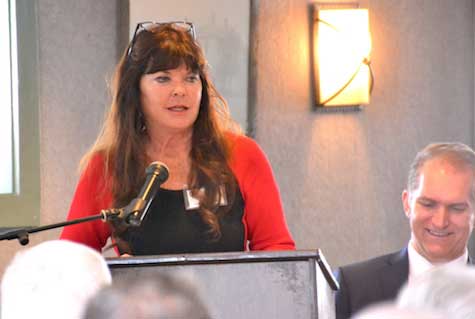County says expanded broadband Internet still a priority
‘We haven’t given up the fight.’ – Lynne Johnson, Legislature chairwoman

Photos by Tom Rivers: Lynne Johnson, chairwoman of the Orleans County Legislature, speaks during Friday’s Orleans County Chamber of Commerce’s Legislative Luncheon at Tillman’s Village Inn. Nathan Pace, moderator of the event, is at right.
ALBION – Orleans County officials remain committed in pushing for more high-speed Internet throughout the county.
Orleans has tried for several years to expand the service into the outlying rural areas, but hasn’t had much success, even with the state’ making $500 million available for expanded broadband.
“We haven’t given up the fight,” Lynne Johnson, chairwoman of the Orleans County Legislature, said Friday during the Chamber of Commerce’s Legislative Luncheon.
Orleans and Niagara have partnered to form the Niagara-Orleans Regional Alliance to push for more broadband, and address other issues for the two counties, including dredging harbors.
The lack of high-speed Internet remains a top concern for the two counties. Johnson said broadband is critical for retaining and attracting residents and businesses. Increasingly, companies file reports online and students can do research and homework through the Internet.
“We will remain fighting for Orleans and Niagara counties to get each and every house wired,” Johnson said.
State Sen. Robert Ortt, R-North Tonawanda, said the $500 million from the state didn’t make much of a dent in reaching underserved areas, like Orleans and Niagara.
The federal government may have funding to help bridge the gap, representatives from U.S. senators Charles Schumer and Kirsten Gillibrand as well as Congressman Chris Collins said during the luncheon.
Johnson said she is hopeful a new rural broadband program through the federal U.S. Department of Agriculture can help in rural Orleans and Niagara.
• Johnson updated about 100 people at the luncheon on other county initiatives including the construction of a $10 million addition to the County Administration Building on Route 31. The county broke ground on the 23,000-square-foot addition in April. The construction is expected to be complete on May 3, with furniture, computers and office equipment to then go in. Employees should be moved over and settled into the new space by late June.
The addition will be used by 50 county employees from the Health Department, Board of Elections, information technology department and the Legislative office and staff. The building will be connected to the current Administration Building with the addition on the south side.
The new space will include a meeting room for the Legislature with about 60 seats. The current Legislative chambers has about 30 seats and is one of the smallest municipal meeting rooms in the county.
• The county will be transitioning to new 96-gallon recycling totes in 2019, with an implementation start date in July.
Residents currently use recycling bins that are emptied weekly by Modern. Modern will be switching to 96-gallon totes that have covers. Those totes can be grabbed by a mechanical arm, lifted into the arm and emptied into the recycling truck.
The change will allow Modern to staff each recycling truck with one employee. The company can also speed up the collection effort, spending an every of 12 seconds per stop.
The county will have public meetings to help educate the public about the new recycling totes, Legislator Ken DeRoller said.

The Orleans County Courthouse, shown last week, will get have a rubberized coating put on the roof this year to protect the dome from leaks.
• The dome for the Orleans County Courthouse needs $140,000 in repairs. The dome has several leaks. The county will have a rubberized coating put on the dome to protect it from leaks. The $140,000 repair on the dome is among $3,181,106 in capital projects for the county in the 2019 budget.
Johnson said work on the pillars on the courthouse will also need attention in the near future.
• The county was asked about its revenue-sharing with local sales tax. There is about $17 million in local sales tax revenue and the county keeps about 92 percent of that. The villages and towns get $1,366,671. The four villages and 10 towns have been frozen at that level since 2001.
The village and town shares shift depending on changes in assessed value. A question submitted to the Chamber about the issue said the revenue shares shouldn’t change based on assessed value.
Chuck Nesbitt, the county’s chief administrative officer the past 14 years, said none of the villages have proposed a different formula for divvying up the sales tax money since he’s been working for the county.
He doesn’t want to see a municipality take a big hit with sales tax, given the era of 2 percent property tax caps.
Larger counties share a lot of the sales tax with towns, villages and even school districts. In Orleans the towns and villages may only get a small percentage, but Nesbitt said most other small counties, at 50,000 people or less, keep all of the sales tax.
He said there are 14 counties at 50,000 or fewer people and eight don’t share sales tax. Of the six that do, he said Orleans shares the most behind only Schuyler County, which has Watkins Glen International Speedway, a significant sales tax generator.
“In our peer group we’re number 2 in what we do with sharing sales tax,” Nesbitt said at the luncheon.
The current formula has resulted in a drop in sales tax for the villages. Their amount has declined by about $27,000 from 2013 to 2019, falling from $404,661 in 2013 to $377,019 for 2019. The villages’ decline has resulted in an increase of about $27,000 among six towns that have a village within their boundaries. Portions of the villages of Albion and Medina are in two towns.
• Johnson said she is optimistic a recent arbitration ruling will free up gambling revenues held back from the Seneca Nation of Indians. The county could receive $350,000 to $400,000 in funds that have been withheld by the Senecas in a dispute with the state.
• The Legislature chairwoman also said she supports making the 2 percent property tax permanent, which was passed by the State Senate. That cap will help prevent property taxes from any hefty increases.





































































